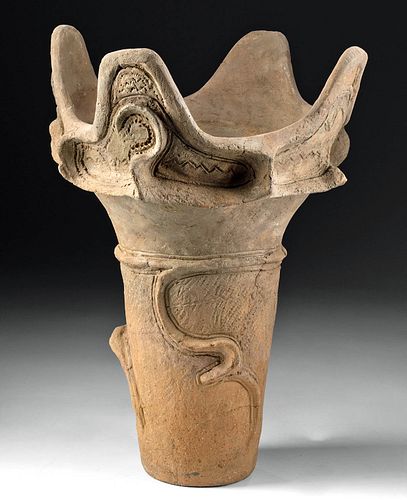Large Japanese Jomon Pottery Jar w/ TL Test
Lot 128
About Seller
Artemis Gallery
686 S Taylor Ave, Ste 106
Louisville, CO 80027
United States
Selling antiquities, ancient and ethnographic art online since 1993, Artemis Gallery specializes in Classical Antiquities (Egyptian, Greek, Roman, Near Eastern), Asian, Pre-Columbian, African / Tribal / Oceanographic art. Our extensive inventory includes pottery, stone, metal, wood, glass and textil...Read more
Categories
Estimate:
$3,500 - $5,000
Absentee vs Live bid
Two ways to bid:
- Leave a max absentee bid and the platform will bid on your behalf up to your maximum bid during the live auction.
- Bid live during the auction and your bids will be submitted real-time to the auctioneer.
Bid Increments
| Price | Bid Increment |
|---|---|
| $0 | $25 |
| $300 | $50 |
| $1,000 | $100 |
| $2,000 | $250 |
| $5,000 | $500 |
| $10,000 | $1,000 |
| $20,000 | $2,500 |
| $50,000 | $5,000 |
| $100,000 | $10,000 |
| $200,000 | $20,000 |
About Auction
By Artemis Gallery
Oct 7, 2021
Set Reminder
2021-10-07 10:00:00
2021-10-07 10:00:00
America/New_York
Bidsquare
Bidsquare : Exceptional Antiquities Ethnographic Fine Art
https://www.bidsquare.com/auctions/artemis-gallery/exceptional-antiquities-ethnographic-fine-art-7537
Museum-worthy examples of Egyptian, Greek, Roman, Etruscan, Near Eastern, Far East / Asian, Pre-Columbian, African / Tribal, Oceanic, Native American, Spanish Colonial, Fossils, Ancient Jewelry, Fine / Visual Arts, so much more! Artemis Gallery info@artemisgallery.com
Museum-worthy examples of Egyptian, Greek, Roman, Etruscan, Near Eastern, Far East / Asian, Pre-Columbian, African / Tribal, Oceanic, Native American, Spanish Colonial, Fossils, Ancient Jewelry, Fine / Visual Arts, so much more! Artemis Gallery info@artemisgallery.com
- Lot Description
Ancient East Asia, Japan, Late Jomon Period, ca. 2000 to 1500 BCE. A hand-built pottery vessel of a tall, sizable form with a flat base, a cylindrical body, and a flared shoulder. The body is adorned with curvilinear relief bands that form abstract, tendril-form motifs, and the surrounding areas exhibit a softened cord-pressed pattern; hence the term "jomon" which translates to "cord pattern." The bulky shoulder is decorated with similar tendrils and corded patterns as well as a quartet of projecting flanges with thick rims and recessed frontal panels. Additional zigzags and linear motifs are incised within some of the shoulder panels to create a wondrous presentation that is sure to accentuate any discerning collection. Size: 15" W x 19.2" H (38.1 cm x 48.8 cm)
The ancient Japanese Jomon Period is known for its distinctive pottery tradition that set it apart from the Paleolithic Age. Jomon pottery vessels are among the oldest in the world and typically present rope- or cord-like impressed decoration. Since no kilns have been excavated from the Jomon period, it is believed that the ancients fired these vessels in open fires.
According to the Metropolitan Museum of Art's Heilbrunn Timeline essay, "All Jomon pots were made by hand, without the aid of a wheel, the potter building up the vessel from the bottom with coil upon coil of soft clay. As in all other Neolithic cultures, women produced these early potteries. The clay was mixed with a variety of adhesive materials, including mica, lead, fibers, and crushed shells. After the vessel was formed, tools were employed to smooth both the outer and interior surfaces. When completely dry, it was fired in an outdoor bonfire at a temperature of no more than about 900° C."
This piece has been tested using thermoluminescence (TL) analysis and has been found to be ancient and of the period stated. A full report will accompany purchase.
This piece has been searched against the Art Loss Register database and has been cleared. The Art Loss Register maintains the world's largest database of stolen art, collectibles, and antiques.
Provenance: private Chicago, Illinois, USA collection
All items legal to buy/sell under U.S. Statute covering cultural patrimony Code 2600, CHAPTER 14, and are guaranteed to be as described or your money back.
A Certificate of Authenticity will accompany all winning bids.
PLEASE NOTE: Due to recent increases of shipments being seized by Australian & German customs (even for items with pre-UNESCO provenance), we will no longer ship most antiquities and ancient Chinese art to Australia & Germany. For categories of items that are acceptable to ship to Australia or Germany, please contact us directly or work with your local customs brokerage firm.
Display stands not described as included/custom in the item description are for photography purposes only and will not be included with the item upon shipping.
#166981Repaired from multiple pieces, with several areas of restoration along upper and lower body, and resurfacing with earthen overlay along new material and break lines. Clear repair to one projecting flange, with chipping and adhesive residue along break lines. Abrasions and softening to finer details across most exterior surfaces, with nicks and encrustations, and darkening to scattered areas. TL drill holes beneath base and along lower rim of protruding shoulder decoration.Condition
- Shipping Info
-
All shipping is handled in-house for your convenience. Your invoice from Artemis Gallery will include shipping calculation instructions. If in doubt, please inquire BEFORE bidding for estimated shipping costs for individual items.
-
- Buyer's Premium



 EUR
EUR CAD
CAD AUD
AUD GBP
GBP MXN
MXN HKD
HKD CNY
CNY MYR
MYR SEK
SEK SGD
SGD CHF
CHF THB
THB














